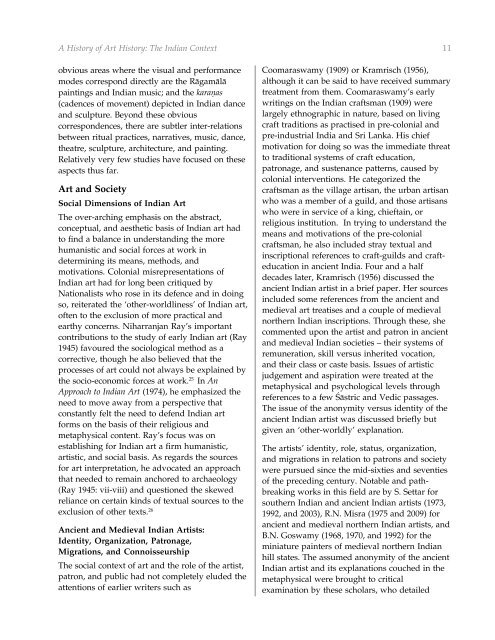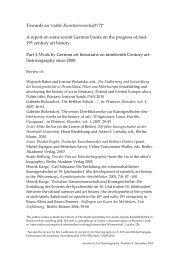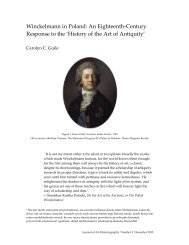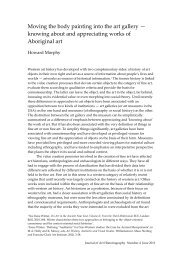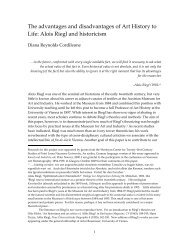Indian Art history.cdr - Journal of Art Historiography
Indian Art history.cdr - Journal of Art Historiography
Indian Art history.cdr - Journal of Art Historiography
Create successful ePaper yourself
Turn your PDF publications into a flip-book with our unique Google optimized e-Paper software.
A History <strong>of</strong> <strong>Art</strong> History: The <strong>Indian</strong> Context 11<br />
obvious areas where the visual and performance<br />
modes correspond directly are the Rägamälä<br />
paintings and <strong>Indian</strong> music; and the karaëas<br />
(cadences <strong>of</strong> movement) depicted in <strong>Indian</strong> dance<br />
and sculpture. Beyond these obvious<br />
correspondences, there are subtler inter-relations<br />
between ritual practices, narratives, music, dance,<br />
theatre, sculpture, architecture, and painting.<br />
Relatively very few studies have focused on these<br />
aspects thus far.<br />
<strong>Art</strong> and Society<br />
Social Dimensions <strong>of</strong> <strong>Indian</strong> <strong>Art</strong><br />
The over-arching emphasis on the abstract,<br />
conceptual, and aesthetic basis <strong>of</strong> <strong>Indian</strong> art had<br />
to find a balance in understanding the more<br />
humanistic and social forces at work in<br />
determining its means, methods, and<br />
motivations. Colonial misrepresentations <strong>of</strong><br />
<strong>Indian</strong> art had for long been critiqued by<br />
Nationalists who rose in its defence and in doing<br />
so, reiterated the ‘other-worldliness’ <strong>of</strong> <strong>Indian</strong> art,<br />
<strong>of</strong>ten to the exclusion <strong>of</strong> more practical and<br />
earthy concerns. Niharranjan Ray’s important<br />
contributions to the study <strong>of</strong> early <strong>Indian</strong> art (Ray<br />
1945) favoured the sociological method as a<br />
corrective, though he also believed that the<br />
processes <strong>of</strong> art could not always be explained by<br />
the socio-economic forces at work. 25 In An<br />
Approach to <strong>Indian</strong> <strong>Art</strong> (1974), he emphasized the<br />
need to move away from a perspective that<br />
constantly felt the need to defend <strong>Indian</strong> art<br />
forms on the basis <strong>of</strong> their religious and<br />
metaphysical content. Ray’s focus was on<br />
establishing for <strong>Indian</strong> art a firm humanistic,<br />
artistic, and social basis. As regards the sources<br />
for art interpretation, he advocated an approach<br />
that needed to remain anchored to archaeology<br />
(Ray 1945: vii-viii) and questioned the skewed<br />
reliance on certain kinds <strong>of</strong> textual sources to the<br />
exclusion <strong>of</strong> other texts. 26<br />
Ancient and Medieval <strong>Indian</strong> <strong>Art</strong>ists:<br />
Identity, Organization, Patronage,<br />
Migrations, and Connoisseurship<br />
The social context <strong>of</strong> art and the role <strong>of</strong> the artist,<br />
patron, and public had not completely eluded the<br />
attentions <strong>of</strong> earlier writers such as<br />
Coomaraswamy (1909) or Kramrisch (1956),<br />
although it can be said to have received summary<br />
treatment from them. Coomaraswamy’s early<br />
writings on the <strong>Indian</strong> craftsman (1909) were<br />
largely ethnographic in nature, based on living<br />
craft traditions as practised in pre-colonial and<br />
pre-industrial India and Sri Lanka. His chief<br />
motivation for doing so was the immediate threat<br />
to traditional systems <strong>of</strong> craft education,<br />
patronage, and sustenance patterns, caused by<br />
colonial interventions. He categorized the<br />
craftsman as the village artisan, the urban artisan<br />
who was a member <strong>of</strong> a guild, and those artisans<br />
who were in service <strong>of</strong> a king, chieftain, or<br />
religious institution. In trying to understand the<br />
means and motivations <strong>of</strong> the pre-colonial<br />
craftsman, he also included stray textual and<br />
inscriptional references to craft-guilds and crafteducation<br />
in ancient India. Four and a half<br />
decades later, Kramrisch (1956) discussed the<br />
ancient <strong>Indian</strong> artist in a brief paper. Her sources<br />
included some references from the ancient and<br />
medieval art treatises and a couple <strong>of</strong> medieval<br />
northern <strong>Indian</strong> inscriptions. Through these, she<br />
commented upon the artist and patron in ancient<br />
and medieval <strong>Indian</strong> societies – their systems <strong>of</strong><br />
remuneration, skill versus inherited vocation,<br />
and their class or caste basis. Issues <strong>of</strong> artistic<br />
judgement and aspiration were treated at the<br />
metaphysical and psychological levels through<br />
references to a few Çästric and Vedic passages.<br />
The issue <strong>of</strong> the anonymity versus identity <strong>of</strong> the<br />
ancient <strong>Indian</strong> artist was discussed briefly but<br />
given an ‘other-worldly’ explanation.<br />
The artists’ identity, role, status, organization,<br />
and migrations in relation to patrons and society<br />
were pursued since the mid-sixties and seventies<br />
<strong>of</strong> the preceding century. Notable and pathbreaking<br />
works in this field are by S. Settar for<br />
southern <strong>Indian</strong> and ancient <strong>Indian</strong> artists (1973,<br />
1992, and 2003), R.N. Misra (1975 and 2009) for<br />
ancient and medieval northern <strong>Indian</strong> artists, and<br />
B.N. Goswamy (1968, 1970, and 1992) for the<br />
miniature painters <strong>of</strong> medieval northern <strong>Indian</strong><br />
hill states. The assumed anonymity <strong>of</strong> the ancient<br />
<strong>Indian</strong> artist and its explanations couched in the<br />
metaphysical were brought to critical<br />
examination by these scholars, who detailed


